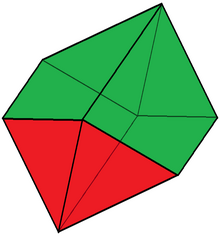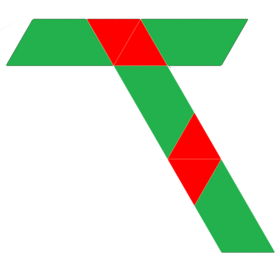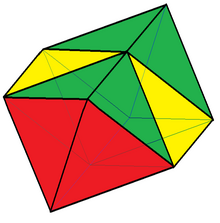| Elongated octahedron | |
|---|---|
 | |
| Faces | 4 triangles 4 isosceles trapezoids |
| Edges | 14 |
| Vertices | 8 |
| Vertex configuration | 4 (32.42) 4 (3.42) |
| Symmetry group | D2h, [2,2], (*222), order 8 |
| Dual polyhedron | self-dual |
| Properties | convex |
| Net | |
 | |
| Deltahedral hexadecahedron | |
|---|---|
 | |
| Faces | 16 triangles |
| Edges | 24 |
| Vertices | 10 |
| Vertex configuration | 4 (34) 4 (35) 2 (36) |
| Symmetry group | D2h, [2,2], (*222), order 8 |
| Properties | deltahedron |
| Net | |
 | |
In geometry, an elongated octahedron is a polyhedron with 8 faces (4 triangular, 4 isosceles trapezoidal), 14 edges, and 8 vertices.
A related construction is a hexadecahedron, 16 triangular faces, 24 edges, and 10 vertices. Starting with the regular octahedron, it is elongated along one axes, adding 8 new triangles. It has 2 sets of 3 coplanar equilateral triangles (each forming a half-hexagon), and thus is not a Johnson solid.
If the sets of coplanar triangles are considered a single isosceles trapezoidal face (a triamond), it has 8 vertices, 14 edges, and 8 faces - 4 triangles ![]() and 4 triamonds
and 4 triamonds ![]() . This construction has been called a triamond stretched octahedron.[1]
. This construction has been called a triamond stretched octahedron.[1]
Another interpretation can represent this solid as a hexahedron, by considering pairs of trapezoids as a folded regular hexagon. It will have 6 faces (4 triangles, and 2 hexagons), 12 edges, and 8 vertices.
It could also be seen as a folded tetrahedron also seeing pairs of end triangles as a folded rhombus. It would have 8 vertices, 10 edges, and 4 faces.
The Cartesian coordinates of the 8 vertices of an elongated octahedron, elongated in the x-axis, with edge length 2 are:
The 2 extra vertices of the deltahedral variation are:
In the special case, where the trapezoid faces are squares or rectangles, the pairs of triangles becoming coplanar and the polyhedron's geometry is more specifically a right rhombic prism.

This polyhedron has a highest symmetry as D2h symmetry, order 8, representing 3 orthogonal mirrors. Removing one mirror between the pairs of triangles divides the polyhedron into two identical wedges, giving the names octahedral wedge, or double wedge. The half-model has 8 triangles and 2 squares.

It can also be seen as the augmentation of 2 octahedrons, sharing a common edge, with 2 tetrahedrons filling in the gaps. This represents a section of a tetrahedral-octahedral honeycomb. The elongated octahedron can thus be used with the tetrahedron as a space-filling honeycomb.
